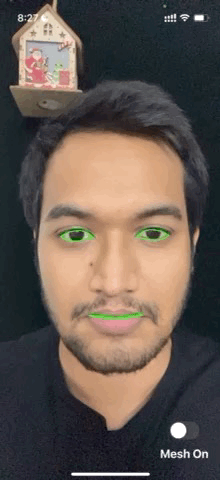Baraba
from Korean:
meaning, Look at me
Make your UIScrollView scroll automatically when user is looking at the screen
Features
- Automatic scrolling for your UIScrollView when user is looking at the screen
📱 👀 - Pauses scrolling when user turns away
📱 🙄 or when starts scrolling👆 - Face Tracking using ARKit or AVFoundation (Your choice!)
- Adjust scrolling speed appropriate for your content
- Complete Documentation
- Supports iOS 11 or above
Demo
Click below image
👉
YouTube
Installation
CocoaPods
Baraba is available through CocoaPods. To install it, simply add the following line to your Podfile:
pod 'Baraba'
Carthage
Carthage is a decentralized dependency manager that builds your dependencies and provides you with binary frameworks. To integrate Baraba into your Xcode project using Carthage, specify it in your Cartfile:
github "nsoojin/baraba"
Run carthage update to build the framework and drag the built Baraba.framework into your Xcode project.
Example
The example application is the best way to see Baraba in action. Simply open the Baraba.xcodeproj and run the Example scheme.
Basic Usage
Just three simple lines of code to get it running!
// Probably in your view controller.
let baraba = Baraba(configuration: .automatic) // (1) Initialize Baraba
override func viewDidLoad() {
super.viewDidLoad()
baraba.scrollView = tableView // (2) Set the scroll view for the auto-scroll target
baraba.delegate = self
}
override func viewWillAppear(_ animated: Bool) {
super.viewWillAppear(animated)
baraba.resume() // (3) Resume to activate camera and start tracking user's face
}
override func viewWillDisppear(_ animated: Bool) {
super.viewWillDisppear(animated)
baraba.pause() // Pause to stop accessing camera
}
Configuration
let baraba = Baraba(configuration: .automatic) // Uses ARKit if supported. If not, uses AVFoundation
let baraba = Baraba(configuration: .ar)
let baraba = Baraba(configuration: .av)
Baraba.isConfigurationSupported(.ar) // Check the device availability
What's the difference?
ARKit uses TrueDepth front camera. Not all iOS devices supports this, so refer to device compatibility. Generally, ARKit has faster face tracking capability so reacts faster to user movement. However, it consumes more energy and may increase the device temperature when used for a long time. The best way to see the difference is to run it for youself. Try the Example app.
Scroll Speed
You can adjust scroll speed with preferredScrollSpeed property, which represents speed in 'points per second'. However, the actual scroll speed will be the nearest multiple of 60. The reason is for smooth scrolling, as the device's maximum refresh rate of the display is 60 frames per second. You can check the actual speed with actualScrollSpeed property if you want. Default is 180.
baraba.preferredScrollSpeed = 240 // baraba.actualScrollSpeed == 240
baraba.preferredScrollSpeed = 100 // baraba.actualScrollSpeed == 120
Pause Duration
When user starts dragging the scroll view, auto-scrolling pauses. After the dragging finishes, auto-scrolling resumes after this duration.
baraba.pauseDuration = 4
⚠️
Important
If you want to use BarabaConfiguration.ar which uses ARFaceTrackingConfiguration, your app must include a privacy policy describing to users how you intend to use face tracking and face data. (See Apple's Note)
Example #1 (This has passed the actual App Store Review.)
You can use this sample at your own discretion.
Don't forget to add Privacy - Camera Usage Description in your app's info.plist file.
FAQ
What's the origin of the name Baraba?
Baraba(바라봐) is a Korean term which means "Look at me".
Contributing
Contributions are very welcome
License
Baraba is released under the MIT license. See LICENCE for details.










